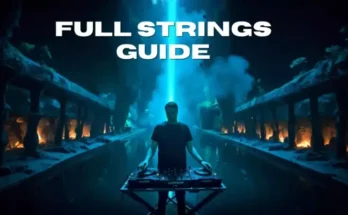MP4 MP3 PDF | 807.38 MB
Power Your Blues Soloing with Diminished Lines
Great jazz-influenced guitar players like Robben Ford, John Scofield, and Scott Henderson use the diminished scale to add a fresh harmonic dimension to their blues solos and improvisations.
Jeff McErlain’s Diminished Blues edition of Take 5 kicks off with a revealing primer on the diminished scale and a versatile collection of guitar-friendly diminished fingerings, both of which will demystify the elusive scale and put it to work immediately in your own blues solos and improvisations.
”This course is near and dear to my heart, as the diminished scale looms large in my own playing. I’m very excited to share with you what I’ve learned over the years through trial and error. I’ll clear up any confusion you might have about the scale and show you how to effectively use the diminished scale in your own blues improvisations and solos.”
After the primer, Jeff guides you through five soloing performance studies, which utilize the diminished scale to create tension and release in a blues solo. You’ll play through a series of studies ranging from start basic approaches to more advanced applications.
Level 1: Diminished Blues
”In this study, we’re going to use a #VI dim7 arpeggio on a blues. The #VI dim7 chord is a chord embellishment very often heard in blues and jazz specifically on bar six. On this example, we’re playing a G blues. So the #VI diminished 7th chord will be C#dim7, C#EGBb. Note how each of the notes are equidistant apart made up of the interval of minor 3rds. As a result, each of these notes can be seen as the root so this chord can be C#dim7, E dim7, G dim7, and Bb dim7. Very cool, and a key element of understanding diminished scales and theory.”
Level 2: Diminished Blues
”Well here it is, The Big Kahuna: The use of the half whole diminished scale on a I7 chord before changing to the IV7 in bar four of a blues. The Robben Ford thing! You know it, you love it, and here’s how to do it. Shhhh, don’t tell anyone… Here we’re encountering the idea of superimposing harmony not present in the chord changes by using the half-whole diminished scale on bar 4 of the blues to add some more musical tension to create a stronger resolution to the IV7 chord. That’s the idea behind what Robben Ford does on a blues when using the scale. The real trick (and probably the most difficult part) here is the phrasing. We need to place the scale just at the right spot for it to work correctly and not sound like a mess!”
Level 3: Diminished Blues
”In this performance study, we’ll check out using the diminished seventh scale once again in a blues on bar four. This is similar to Robben Ford’s version of “Talk To Your Daughter”. We’re going to employ the same idea as the previous example, but now using 16th notes for a bit more excitement. Wanna make stuff sound hipper? Don’t start on a downbeat. This is good advice across the board in any style of playIng. In this particular example, I’m starting on the second 16th note beat one. This will add a nice forward motion to the line adding a little bit more tension making the resolution on the downbeat of a bar five all that much sweeter. It takes some practice, but it’s not that difficult once you start to hear the syncopation of that rhythm.”
Level 4: Diminished Blues
”In this performance study, we’re going to use a C half whole diminished scale right off the top of a song to bend the ear little bit. This is a cool way to set up the idea that some interesting sounds are coming your way. Like all musical devices, many of these are genre specific. If I’m playing a traditional Muddy Waters type blues, chances are really good I won’t be using a diminished scale. It can be done, but often stylistically it doesn’t fit. So keep that in mind when experimenting. In this application, we use the diminished scale as more of an overall sonic effect. Meaning, right off the top, we’re bending the harmony a little bit. And since it goes by so quickly, I hear it more as a sheet of sound…to use a phrase used by John Coltrane; to create an overall feeling and harmony. It’s basically a melodic pattern in the scale, but it’s very effective as an overall sound.”
Level 5: Diminished Blues
”In this last performance study, I’m using the diminished scale in more of a jazz fusion way. For me, this is directly related to Miles Davis and his open modal approach to one chord vamps. The beauty of the diminished scale is that it contains both a major third and a #9 which can also be seen as a b3rd. So, the harmony below is purposely left somewhat ambiguous, the chord I’m using is basically E7#9, the chord has both the major 3rd and b3rd (#9) so we can really have some fun with the harmony. As I stated, we have a blues scale in there too so we can, and I do, weave in and out of the diminished scale and the blues scale. It’s super cool!”
Jeff will explain and demonstrate all of the key concepts and approaches along the way. You’ll get standard notation and tabs. Plus, Jeff includes all of the backing tracks for you to work with on your own. In addition, you’ll be able to loop or slow down any of the videos so that you can work with the lessons at your own pace.
Grab your guitar and let’s play some diminished blues with Jeff McErlain!
[toggle title=”Home page”]https://tinyurl.com/y4xkvlxt[/toggle]

http://alfalink.to/cb445e7487bb6fe51ea7
Please REPORT in Comment Broken Links




